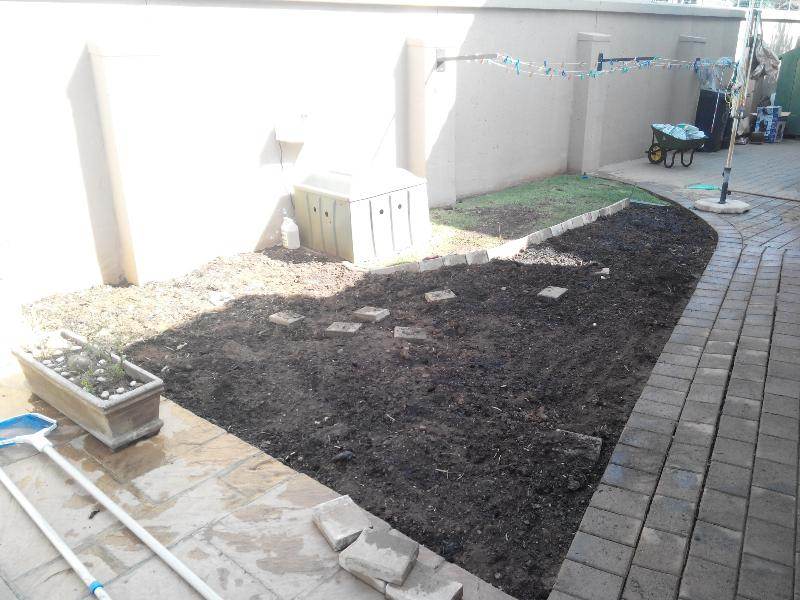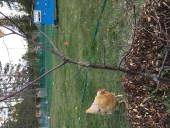
 1
1




 1
1





 1
1




"We're all just walking each other home." -Ram Dass
"Be a lamp, or a lifeboat, or a ladder."-Rumi
"It's all one song!" -Neil Young





 1
1




List of Bryant RedHawk's Epic Soil Series Threads We love visitors, that's why we live in a secluded cabin deep in the woods. "Buzzard's Roost (Asnikiye Heca) Farm." Promoting permaculture to save our planet.




Bryant RedHawk wrote:Hi Ricky, welcome to Permies.
It sounds to me like you have a good plan for intensive planting in that space.
The potatoes have started the breakup of the hard clay (here we call that hard pan) soil. I would think that if the potatoes did as well as you say, that other things such as daikon radish, carrot, etc. would continue the loosening of the hard pan. If you can get it, some cotton seed meal or hulls would also help with the breakdown of the clays into more friable soil.
The trick with clays is to get the microscopic particles of clay something to cling to other than each other.
The topping of compost/potting soil you've added will work into the ground slowly as you water the space. Giving the space a broad forking would speed that process up, without turning the soil.
You could curb the white fly attacks with a spray made of comfrey tea or even nicotine spray.
Would love to see some pictures of the progress you make.












 1
1




List of Bryant RedHawk's Epic Soil Series Threads We love visitors, that's why we live in a secluded cabin deep in the woods. "Buzzard's Roost (Asnikiye Heca) Farm." Promoting permaculture to save our planet.




Bryant RedHawk wrote:Yes, wood chips would work well as a topping for the compost. It sounds like you would probably want fairly large pieces on the surface to keep the wind from blowing anything into Dad's pool.
Just about any meal should be of benefit, another item that would work is rice hulls, be aware though that in our rice belt there are literally millions of pounds of them in piles that have been around for at least 25 years that I know of. The only way I have ever used rice hulls (other than as a path mulch) is to soak them in a mildly caustic solution (I made some hardwood lye for soap making and diluted some of that in a 1:25 solution), then rinse the heck out of them,(catch all the effluent so it won't pollute anything or place. In my case I used the rinse water thus collected to treat a spot that was very acidic soil, it worked very well for me). When this treatment is done, the rice hulls will start to decompose.
You have a great set of plants picked out already, not sure I could offer any suggestions better than what you picked.
The composting will gather up lots of those pesky clay particles, you might just wait a year and then see how friable the soil has become before amending further. If you see crusting, a little bone meal or ground shells worked into the top few centimeters might help keep that from happening
















I can get alfalfa meal or lucerne meal that they grow outside the city here although the farmer doesnt seem to keen on making a delivery here & its cheap at like 8$ for 55 pounds, i have looked for rice hulls over here & the only place i could find was at this one beer brewery & they imported from your side so they cost a load, i know rice hulls are excellent for aeration in potting mixes with a good amount of silica although i like the way you use them, thats awesome that you can make lye from it aswell i never knew that !
I Will be adding a another bag of compost after ive finished screening it for the seedling mix would you you recommend me sprinkling some rockdust on top though ? Hopefully my dad can let me know how its going after a year but ill definitely keep in mind to tell him to add some bone meal or some ground shells,
As for the selection i will be adding in some mint & rocket to the list although im thinking if i should try place some pioneers amongst them ?
List of Bryant RedHawk's Epic Soil Series Threads We love visitors, that's why we live in a secluded cabin deep in the woods. "Buzzard's Roost (Asnikiye Heca) Farm." Promoting permaculture to save our planet.




















 1
1




List of Bryant RedHawk's Epic Soil Series Threads We love visitors, that's why we live in a secluded cabin deep in the woods. "Buzzard's Roost (Asnikiye Heca) Farm." Promoting permaculture to save our planet.
 1
1




 1
1




 1
1




Bryant RedHawk wrote:Herbs are always great to have on hand. I have herb beds for cooking and for healing. Mulch also helps keep soils from the sun, I usually mulch after I have everything planted, but I start seeds and then transplant for small beds. Larger spaces I generally seed directly, then spread the mulch as the new life reaches for the sky.
I always try to use a ground cover that will help the crop plants (some clovers are good but I use them mostly around the fruit trees since they can grow tall enough to be a problem with lower growing crop plants). You have herb seeds, that is great, I would use them for in between planting/soil shading, since you then don't have anything growing that is single purpose.
No, I think either of those meals would be sufficient. It is very easy to get to mixing a soil for optimum growth and then find, by the reactions of your crop/s that you over did it, which in my experience takes longer to correct. I always try to add as few items to a blend as possible at first then, when the plants show me they need something that I didn't add, bring that or those items into the soil party, usually as a top dressing.
Soil building is perpetual by its very nature, earth mother is never through, and that is how it is supposed to be. There is great calmness brought to those who are sitting in the dirt and getting along with the earth mother, becoming one who helps her with her work is a noble thing to do. Instead of thinking you can be manipulating her, which may work in the short term but will most certainly eventually kills her spirit. We are supposed to be living with the earth, not living on it.




Ce Rice wrote:As I understand your efforts, you are in the learning phase. Just keep doing what you are doing, practicing on foods that are produced/available in your area. Those are the best ones to start with.
Don't be afraid to fail. Try any and all you have space for. Try and try again. It is such a fun experience gardening for the first time.
One possible suggestion: sweet potatoes
Would take some effort, but plant them on the perimeter of the garden to help prevent things blowing into the pool. The vines will grow, so just keep moving them, training them back towards the edge. Layer and overlap them as needed. Also, look for their root nodes along the vines and cover those nodes with a handful or three of soil. More sweet potatoes can grow from those nodes. Sweet potatoes are not potatoes. Or not white potatoes. Not cousins. So they grow a little different.
Or, with that mention of Herbs, instead of sweet potato on the perimeter/edge, you could grow Creeping Thyme. It is a great herb, and it fills that role of securing the edge, so weeds don't grow in the edge and stuff doesn't blow off/out of the garden space. And just step on/cut off the thyme as it grows over your stone too much. It doesn't every hurt to be walked on, plus, lets off a beautiful light smell when you do walk on it.
 1
1




Success has a Thousand Fathers , Failure is an Orphan
LOOK AT THE " SIMILAR THREADS " BELOW !
 1
1





 1
1




Ricky Riccardo wrote: a few gooseberry plants that are trying to survive their whitefly attack.








Tim Malacarne wrote:Welcome! I agree with the advice above to try some sweet potatoes. They are good for you and easy to grow. They'd like loose soil, so as to easily form the fruit. I have had good luck using them to shade other, less heat tolerant plants, such as rhubarb. You can train sweet potato vines to grow most anyplace you provide a support. Good luck! Best, TM




Leila Rich wrote:
Ricky Riccardo wrote: a few gooseberry plants that are trying to survive their whitefly attack.
I was about to post something about how enormous and thorny European gooseberries are,
then realised you might well have Cape gooseberries?
If they are Cape gooseberries, unless you're crazy about them I'd consider only keeping the best-looking plant.
They're wildly productive, grow really big and are really 'gangly', flopping all over the garden.
A great thing about them is they're happy in the shade.
I've had zero experience with whitefly,
but I always assume those kind of attacks are because the plant's stressed or something in the environment's out of balance.
 1
1








alex Keenan wrote:From some research and testing over a decade ago, if you added 20% expanded materials like perlite, expanded shale, etc. to the subsoil and topsoil you should not have issues with soil compaction.
Your soils has macro pores, meso pores, and micro pores. Clay has lots of surface area but only micro pore space. Sand has lots of macro pores but does not hold water. It is the meso pores that will hold free water the plants can use. I like organic material with all the life in it to build porespace. However, you tend to find that in nature organic material decreases as depth increases form leaf litter layer down to subsoil. If you want good deep roots in clay consider double digging and amending with porous non-organic material in the subsoil and with organic and non-organic material in the top soil.
This will badly disrupt the soil but it is also a one time event. With this start you should be able to cover crop and/or mulch from that point forward.

|
the force is strong in this tiny ad
The new kickstarter is now live!
https://www.kickstarter.com/projects/paulwheaton/garden-cards
|


